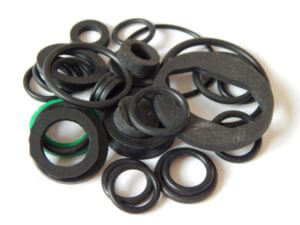Preventing Seal Leaks
O-Rings: How a Small Part Plays a Huge Role
One of the attributes that determine the quality of a valve or fitting is its seal. A leak-proof control valve seal is not only desired but is an absolute necessity in many applications.
Leaking valves (or fittings), under the wrong circumstances, can allow toxic substances into the atmosphere or environment. Escaping oxidizers can lead to fire or explosion. And valuable products may go to waste.
Although it’s not the only factor involved, the O-ring is a crucial player in providing a no-leak high- (or low-) pressure control valve seal.
Since they were first patented in 1896 in Sweden by J.O. Lundberg, O-rings have become the standard in leak-proof design. (The U.S. patent was not issued until 40 years later to Niels Christensen.) The U.S. military created such a demand for them that the government took over the patent in order to have them manufactured by different companies for military aircraft use.
Jump forward another 15-20 years to the 1950s. CPV Manufacturing designed a full line of leak-proof valves and fittings using O-ring seals for the U.S. Navy.
Today, O-rings are the most sure-fire way to prevent seal leaks, and they are widely used across the world for leak-free valve and fittings.
Advantages of O-Rings
O-rings have a number of advantages over other types of seals.
Tight seal
Because they are almost all made of elastomers they can conform to hard surfaces to form a bubble-tight seal. When used correctly with a recessed close-tolerance groove, the internal system pressure (or external pressure) pushes the O-ring against the edge of the groove, forming a seal.
High pressure tolerance
Because of this O-ring face seal design, the bi-directional seal becomes tighter with increased pressure. The maximum pressure that an O-ring can withstand is dependent on the design of the system. Those with a smaller extrusion gap can handle higher pressures.
Make and break
The use of O-rings in valves and fittings allows for low-torqueing connections. There is no deformation of metal needed due to high torqueing requirements. They can be detached and reattached repeatedly without compromising the seal.
Ease of replacement
Use of O-rings in flat faced unions allows for versatility within the system that could never exist otherwise. CPV’s O-SEAL® line is the perfect example. Components can simply be lifted out and replaced with no cutting required.
Versatility in applications
O-rings come in almost any size and can be made of a number of different materials, which means there’s an O-ring for just about every application.
Material Selection
Choosing the right material for the intended use requires gathering some important information. Of critical importance when deciding on the right elastomer for a valve are:
Operating temperature
The temperature range at which an elastomer will retain its elasticity varies by material. For example, Viton® (fluorocarbon) can handle heat up to 400°F (204°C), but its low temperature limit is only -15°F (-26°C). Buna-N (nitrile), on the other hand, has a low temperature threshold of -65°F (-54°C) but a maximum of only 225°F (107°C).
Media composition
 The elastomer can only be selected once the system fluid or gas is known. For example, oxidizers will degrade some materials while petroleum oils and/or fuels will damage others.
The elastomer can only be selected once the system fluid or gas is known. For example, oxidizers will degrade some materials while petroleum oils and/or fuels will damage others.
The extent to which the process chemicals will attack the elastomer is compounded by the operating temperature. The amount of damage will roughly double for every 18°F (10°C) of rising temperature.
Environmental conditions
Because the seal will be partially exposed to the external environment, those conditions also need to be taken into account. Outside temperature as well as pressure and chemical composition (for example, in an underwater valve) will all be in contact with, or will directly affect, the seal.
Common O-Ring Materials
Due to their tolerance levels for many of the chemical compounds that are used in industry, Viton®, Buna-N, and EPDM (ethylene propylene diene monomer rubber) are some of the most commonly used elastomers in O-ring seals. In general, these three are used as follows:
Buna-N
Good resistance to: petroleum-based oils and fuels, water, alcohols, and some acids and bases
Poor resistance to: strong oxidizers, acetone, and methyl ethyl ketone,
Viton®
Good resistance to: chemicals and oils (preferred for oil refining and chemical processing due to high temperature tolerance)
EPDM
Good resistance to: alcohol, acetone, solvents like methyl ethyl ketone, water, and steam
Poor resistance to: petroleum-based oils
Installation
Proper installation can mean the difference between a leak-proof seal and a disaster. Leakage can occur both around the seal and through it if not designed and installed correctly. Always follow the manufacturer’s installation instructions.
A few points worth emphasizing:
- only use compatible lubricants when needed
- never allow an O-ring to come into contact with any sharp edges or abrasive surfaces
- always stretch the O-ring evenly and to within the specifications of the specific elastomer
Summary
O-rings made by our leak proof valve manufacturers and suppliers may appear to be just a small component of a valve or piping system, but they play a significant role in maintaining a leak-free process.
As leak proof valve manufacturers and suppliers, CPV’s O-SEAL® line of valves and fittings are the industry standard for no-leak, enduring performance. Take a look at our product lines or contact us to find out how we can help fill all of your valve and fitting needs.

